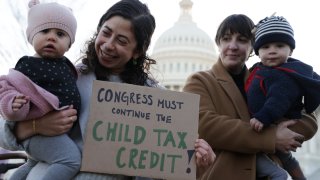
On Sunday, Sen. Joe Manchin, the conservative Democrat from West Virginia, said that he would not support the Biden administration's $1.75 trillion Build Back Better agenda, likely killing the bill and with it the extension of the enhanced child tax credit.
Without the enhanced credit, nearly 10 million children are at risk of falling back below the poverty line or slipping even deeper into poverty, according to an analysis from the Center on Budget and Policy Priorities, a progressive think tank.
Another 27 million will lose all or part of the credit, including roughly half of Black and Latino children and those in rural areas. All 65 million kids that are eligible for the credit will get less in the new year.
More from Invest in You:
Four unhealthy beliefs about money you may have learned in childhood
Your financial wrap-up: 4 savvy money moves to make before year-end
The December child tax credit payment may be the last
Get South Florida local news, weather forecasts and entertainment stories to your inbox. Sign up for NBC South Florida newsletters.
"I'm definitely concerned that families will be surprised, and unlike in July when [the child tax credit] would have been a positive surprise, this time it will be a negative surprise," said Elaine Maag, a principal research associate at the Urban-Brookings Tax Policy Center.
Enhanced child tax credit
The American Rescue Plan, enacted in March, expanded the existing child tax credit, increasing the amount and scope of the benefit.
Money Report
The credit was increased to $3,000 from $2,000 with a $600 bonus for kids under the age of 6 for the 2021 tax year. It also established monthly payments, which began in July and go through December with deposits of $300 for children under the age of 6 and $250 for those aged 6 to 17. The second half will come when families file 2021 tax returns next year.
The enhanced credit also reached more children than ever because it was made fully refundable, meaning that families without earned income could still claim the benefit for eligible kids.
In just a few months of families receiving payments, data showed how the enhanced credit helped. Financial instability fell, more children had enough to eat and some parents were even able to work more.
Continuing the enhanced benefit could have a significant impact on child poverty. Keeping the credit beyond 2021 would reduce child poverty to about 8.4% from 14.2%, a fall of roughly 40%, according to a study from the Urban Institute.
Without an expansion
To be sure, the child tax credit won't go away entirely. Instead, families will still be able to claim the regular child tax credit when they file 2022 taxes in 2023.
But, that credit is much smaller, doesn't come with monthly payments and won't go to as many children as the enhanced benefit did.
Because of these changes, thousands of dollars suddenly will suddenly disappear from family budgets overnight.
For example, a single mother who works full time at the federal minimum wage and has a toddler and a second grader is getting $6,600 this year through the child tax credit, said Kris Cox, deputy director of federal tax policy at the Center on Budget and Policy Priorities.
If the enhanced credit lapses at the end of the year, the same family would get only $1,800 through the child tax credit in 2022. That's a $4,800 difference.
"That's really significant money that could go to support that family," said Cox.
In addition, data showed that parents largely spent the monthly payments on necessities such as groceries, school supplies and boosting savings.
"Monthly payments provide support to families throughout the year," said Cox. "Rent, electricity, food, childcare, transportation — all of these costs occur on a monthly basis."
What families can do now
Families don't have much time to prepare for the lapse in monthly payments. The last check went out on Dec. 15.
What they can do now is review and revise their January budget, said Maag.
"Families do that all the time — they juggle bills, they choose which ones to pay, they forgo opportunities in order to make sure they have enough money to cover their needs in the next month," Maag said.
They can also prepare to file their 2021 taxes to get the second half of the credit as soon as possible next year. Part of this process is making sure they got all the payments they were owed this year, said Trenda Hackett, CPA and technical tax editor of the tax and accounting business at Thomson Reuters.
"I would recommend they log into the CTC portal to check their payment status and see what the IRS says as to the amount of payments they have received," said Hackett. Families can also track lost or missing payments, she said.
Families should also look out for correspondence from the tax agency called "Letter 6419," which will show the agency's record of child tax credit payments. They will need to submit this when they file their 2021 taxes.
SIGN UP: Money 101 is an 8-week learning course to financial freedom, delivered weekly to your inbox.
CHECK OUT: How to make money with creative side hustles, from people who earn thousands on sites like Etsy and Twitch via Grow with Acorns+CNBC.
Disclosure: NBCUniversal and Comcast Ventures are investors in Acorns.






